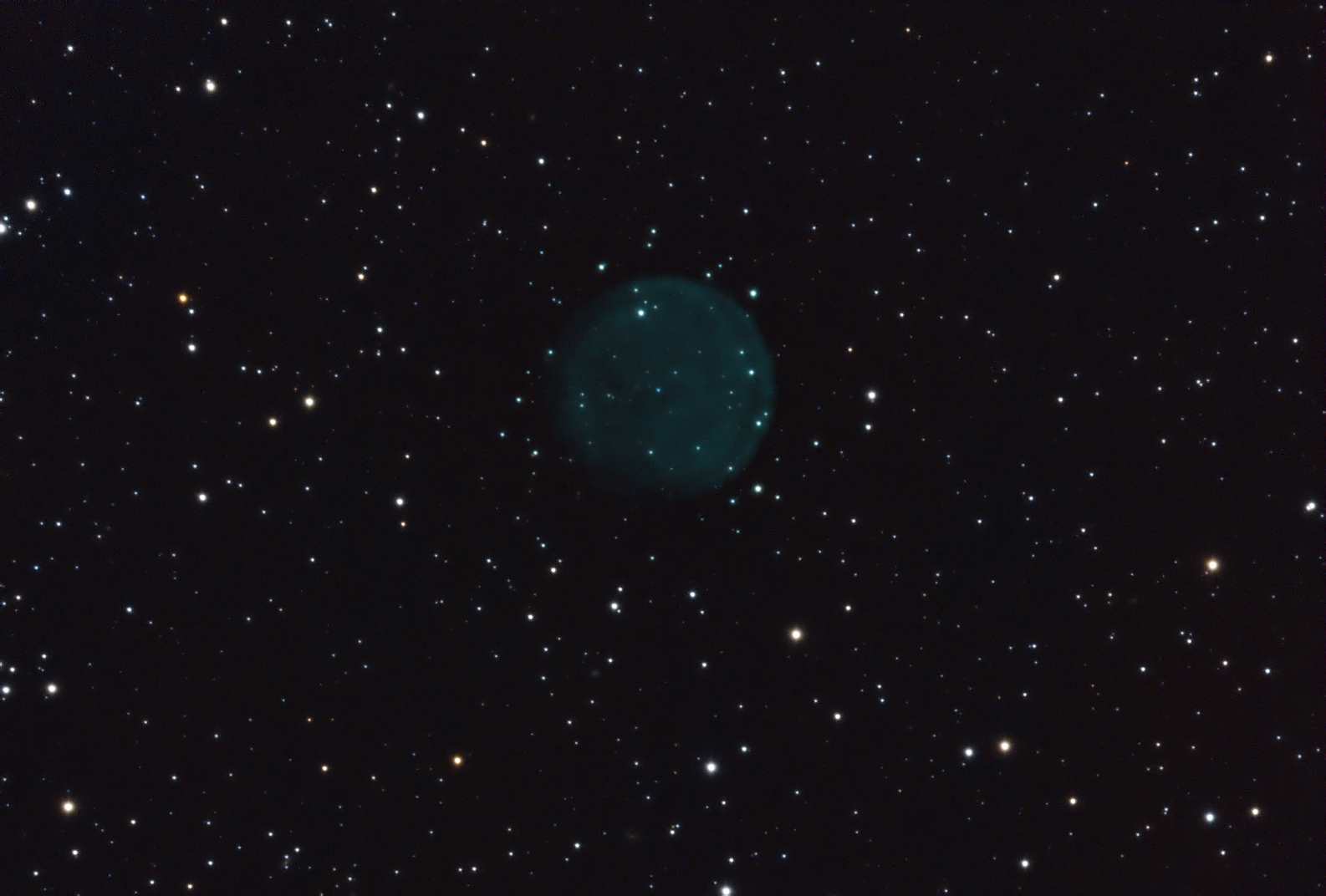
Abell 61 is an old, evolved planetary nebula, about the size of the M97 – The Owl, although much fainter. It is measured 3.4′ in diameter – about 4 light years across, and is located 4,566 light years away from us in a beautiful star field of Cygnus.
To me it looks like to be one the most photogenic PN I have imaged so far. In the narrowband [O III] line, its surface brightness increases steadily from ESE to WNW, and it shows a brighter rim in the WNW. Vast majority of Abell 61 is chemically all [O III], although observations from various sources indicate some [Ha] and/or [N II] lines are present.
This nebula is rarely imaged. Perhaps, the best image of Abell 61 I have seen so far was from the 60cm Hypergraph from the Capella Observatory at Crete, Greece. Abell 61 has low surface brightness, thus demanded 45 minute exposures for a total of 6 hours through the 3nm narrowband [O III] filter in order to reach barely acceptable signal level with my 25cm telescope. Abell 61 is about 22,000 years old and is currently at it’s late stage of expansion. It’s material, weighing at 0.55 Solar masses and 88,200 deg K hot, is expanding with a velocity of about 30 km/s. A 17 magnitude variable star NSV 11917 is shining at its center, and many stars and some tiny anonymous galaxies are visible through the round oxygen glow.
One distinctive feature of Abell 61 that raises scientific discussion is its expanding rings at the periphery. In 1994, Kwitter mentioned that Abell 61 is a planetary nebula that interacts with the interstellar medium (so called PN-ISM interaction), due to that it has asymmetric brightening – an increase of flux at its edge. As planetary nebulae expand and move through space with supersonic speeds, they become influenced by the conditions of the surrounding ISM. This interaction can fragment the halo of the PN and therefore allow the ISM to flow into the inner regions of the PN, shaping its morphology. Was it the reason for the rings? As suggested by Zijlstra in 2006, Abell 61’s binary central star could be the culprit. The relatively thin expanding rings seen in various nebulae, including the Abell 61, could be the result of the central star having a close companion, with a period of hours to days, and the rings could appear due to the complex mass loss process that occurs inside. Here is my own take on this: could the rings be due to that Abell 61 is a bipolar PN, seen edge on? This looks like that if you imagine this shape in perspective. The axis runs from upper left to bottom right and we observe two rings with flux appearing increased where they overlap.
[layout cols=”2-3″ position=”first” textalign=”left”]
Image Data
Telescope: 10″ Aries f/15 Maksutov-Cassegrain on Astro-Physics 900GTO German Equatorial
Accessories: Moravian G1-0300 as Off-Axis Guider, 0.67X Astro-Physics CCD Telecompressor
Focal Length and Resolution: 2692 mm, 0.52″/pixel
Instrument: QSI 532wsg at -20 deg. C
Exposures: Narrowband [O III] 3nm: 6 hours, RGB: 2 hours, Total: 8 hours
Filter(s): Astrodon Narrowband and Tru-Balance E-Series
Exposure Date: 26-29th June 2011
Seeing, FWHM: 1.3–1.5″
Processing Software: MaximDL, PixInsight, Photoshop
Image Acquisition Software: MaximDL, TheSky6, CCDAutoPilot, FocusMax, PinPoint
[/layout]
[layout cols=”1-3″ position=”last” textalign=”left”]
Object Data
Constellation: Cygnus
Type: Planetary Nebula
Distance: 4,566 ly
Dimensions: 3.4′
Magnitude: 13.5 (V)
[/layout]
Processing Procedure
1. Calibrate, Register and Integrate using PixInsight, Vincent Peris procedure.
2. LRGB Combine, Automatic Background Extraction and Background Neutralization on RGB.
3. RGB Color Calibration using galaxies as white references, then SCNR to remove Green and increase Saturation.
4. Histogram Transform on RGB.
5. ACDNR to remove chrominance noise on RGB.
6. Resample and A Trous Wavelet Transform (1st layer +0.25) and K-sigma noise thresholding to remove noise.
7. On [O III] data: Automatic Background Extraction, K-sigma thresholding, Histogram Transform and resample.
8. In Photoshop: combine RGB and [O III] data via Screen overlay. Adjust histogram to reach final balance background color. Levels. Noise reduction.
SIMBAD Query
Papers on this object can be obtained via SIMBAD astronomical database hosted by the Centre de Données astronomiques de Strasbourg.